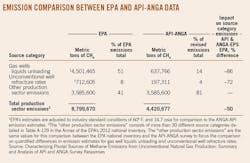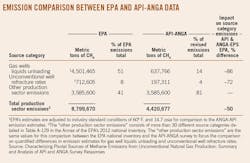API-ANGA blast EPA for exaggerating unconventional wellsite emissions
The US Environmental Protection Agency has overestimated methane emissions from unconventional natural gas well operations, including well completions and hydraulic fracturing, in its latest greenhouse gases emissions inventory, two trade associations said.
The American Petroleum Institute and America's Natural Gas Alliance surveyed members about methane emissions from wells and commissioned URS Corp. and the Levon Group to analyze survey results and write a 48-page report, released in June (OGJ, June 11, 2012, p. 23).
The ANGA-API report estimated methane emissions from gas wells at 4.42 million tonnes compared with the EPA's estimate of 8.79 million tonnes (see table).
Meanwhile, EPA said the natural gas industry was the largest source of US methane emissions, while API-ANGA said "enteric fermentation" from cows and other ruminants actually was the largest nationwide source.
"The EPA has been upfront that its data is limited in scope," said Tom Amontree, ANGA executive vice-president. "This study confirms that EPA's estimates on emissions from operations are vastly exaggerated."
In its study, "Characterizing Pivotal Sources of Methane Emissions from Unconventional Natural Gas production: Summary and Analysis of API and ANGA Survey Responses," API-ANGA said the US government lacks a single coordinated, cohesive set of estimates for gas wells.
EPA responded, saying it would consider the API-ANGA report. "We are always open to reviewing relevant information that may help inform the science around important standards," EPA said.
Howard Feldman, API's director of regulatory and scientific affairs, said, "The issue of what the emissions are from the industry is not over. Companies will be reporting [emissions] to the EPA later this year."
In April, EPA issued its final rule on reducing emissions from oil and natural gas operations, extending the deadline for full compliance with the new rule until 2015. Upon full compliance, the agency expects about a 95% reduction in volatile organic compound (VOC) emissions from some 11,000 new wells per year that involved fracing (OGJ, Apr. 23, 2012, p. 24).
Industry's use of reduced emissions completions (REC), or green completions, is expected to slash emissions. Although industry has considered costs in relation to REC, Feldman noted the API-ANGA emissions report did not examine operating costs.
API-ANGA launched its gas well emissions survey after EPA introduced new calculation methods in 2011 for estimating methane emissions from gas operations.
Feldman said the API-ANGA emissions estimate is more accurate because the trade associations based their conclusions on 91,000 wells distributed over a much broader geographic area than EPA's data, which was derived from 8,800 wells.
Industry has been drilling 40,000-50,000 wells/year in the US in the past decade, during which time the share of total wells in unconventional plays has been growing.
Estimate methodology differences
The two trade groups said EPA incorrectly calculated a nationwide emissions estimate based on four data points from an old Natural Gas Star Program sample never intended for such calculations. The API-ANGA report cites an IHS Cambridge Energy Research Associates private paper entitled "Mismeasuring Methane."
IHS outlined several concerns, saying the revised EPA methane estimate was based on four data points gas well operators voluntarily submit under the Natural Gas Star Program. IHS said the Natural Gas Star statistics were provided to demonstrate emissions reductions already achieved and were never intended for use by the EPA to extrapolate a nationwide emissions average from total US gas wells.
EPA's estimates are based on assumptions that do not reflect current industry practices and should be reevaluated, IHS CERA said (OGJ Online, Aug. 25, 2011).
"Methane emissions have become a very important and controversial issue given their potency as a greenhouse gas," said Mary Barcella, IHS CERA director of North American natural gas. "Unfortunately, such emissions are not being measured. Estimates are being used that are not supported by data, do not reflect current industry practice, and would be unreliable to use as a base for decision-making."
The API-ANGA study said its members uniformly believe EPA's GHG emissions estimates were overstated due to erroneous activity data in several key areas--including liquids unloading, well refracturing, centrifugal compressors, and pneumatic controllers.
Industry defines liquids unloading as the removal of water and other liquids from the wellbore to improve the flow of gas.
The trade associations gathered information on gas well types, gas well venting-flaring from completions, workovers, and liquids unloading, and the use of centrifugal compressor and pneumatic controllers.
EPA did not directly solicit input from industry, even though EPA's revised estimates could have "enormous" consequences upon shale development, API and ANGA said.
Gas well inventories
Gas producers noted large discrepancies among different sources of national well data.
The EPA, the US Energy Information Administration, and IHS report different well counts and do not consistently distinguish between conventional and unconventional wells.
For its report, API and ANGA defined unconventional wells as shale gas wells, coalbed methane wells, and tight sand wells that must be fractured to produce at economic rates. EPA did not provide a breakout of completions by wells type: shale, tight gas, or CBM.
"Furthermore, there does not appear to be a single technical description for classifying wells that is widely accepted," the study said. "Without consistent measures and definitions for the quantity and type of wells, it is difficult to reach agreement on the number of unconventional wells completed annually—let alone their emissions."
API-ANGA surveyed more than 20 companies operating 91,000 wells in 19 of the 21 basins designated by the American Association of Petroleum Geologists, which illustrates the data's wide geographic scope.
Feldman said API-ANGA results more heavily represented gas wells in specific AAPG basins than did EPA. For instance, EPA's data appear not to have included all Marcellus shale wells, particularly in Pennsylvania.
API-ANGA's data were heavily influenced by AAPG 160 (Appalachian basin) and 160A (Appalachian basin-Eastern Overthrust area) while EPA's data were not, Feldman said. He believes API-ANGA's survey was more representative of the industry nationwide than the EPA estimate.
API and ANGA members suggest its survey represents the most comprehensive data set ever compiled for gas operations and therefore provides a "much more accurate picture of operations and emissions."
Information to characterize producing gas wells was collected in two parts:
• The survey requested high-level information on the total number of operating gas wells, the number of gas well completions, and the number of gas well workovers that involved hydraulic fracturing. Data on some 91,000 wells were collected primarily for 2010 with some information provided for the first half of 2011.
• The survey requested more detailed well information about key activities.
ANGA and API members said it's essential to gather additional data about actual emissions and points of uncertainty during unconventional gas production to improve GHG life cycle analysis of gas to focus the discussion around "real data," to promote future measurement and mitigation of emissions from gas production, and to help improve the emission estimation methods EPA uses for gas production in its national GHG inventory.
Feldman said GHGs emission information allows oil and gas companies, the public, and regulators, to measure and track the industry's environmental footprint. He believes the API-ANGA emissions estimate provides a good baseline regarding emissions from US natural gas production.
"Industry is voluntarily reducing its environmental footprint and not waiting for regulatory mandates or incentives to continue to make progress," Feldman said. "The technology and equipment used to reduce emissions were created by the industry, and companies are already implementing those technologies in locations where it is most effective."
More Oil & Gas Journal Current Issue Articles
More Oil & Gas Journal Archives Issue Articles
View Oil and Gas Articles on PennEnergy.com
About the Author
Paula Dittrick
Senior Staff Writer
Paula Dittrick has covered oil and gas from Houston for more than 20 years. Starting in May 2007, she developed a health, safety, and environment beat for Oil & Gas Journal. Dittrick is familiar with the industry’s financial aspects. She also monitors issues associated with carbon sequestration and renewable energy.
Dittrick joined OGJ in February 2001. Previously, she worked for Dow Jones and United Press International. She began writing about oil and gas as UPI’s West Texas bureau chief during the 1980s. She earned a Bachelor’s of Science degree in journalism from the University of Nebraska in 1974.


